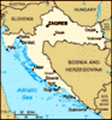Advertisement
Published: August 3rd 2015
July 11 I came to Zagreb from Belgrade on the 11
th of July. The bus departed at 11-30 and arrived at about 16-30 to Zagreb’s main bus station. Though the location of my hostel was quite close to the station I failed to find it easily at first because I had photographed the map on my phone with poor quality and was unable to discern the street’s name. However, I went in the correct direction right from the start.
I tried to find a newspaper stand or something like that to buy a map. Of course I had better take a map from the train station or the bus station right after my arrival, but the thought didn’t cross my mind. I bought a very expensive map near the train station, instead of taking a free one at the station. You are simply not quick-witted sometimes. The hostel was actually located quite close from there, that is both from the bus station and from the train station. The hostel’s name was My Way Hostel, I checked in and began my sightseeing at exactly 17.30.
Zagreb was founded in 1094 with the help of Hungarian king Laszlo I. It
became the capital of Croatia in 1776 instead of the town of Varazdin (I visited in on the 13
th of July).
The first major sight I saw was the Cathedral of Assumption of the Blessed Virgin Mary. The district where it is located is called Kaptol, like in the ancient times. The hilly part of the city is called Gornji Grad (the Upper City). The first cathedral on this spot was built in 1175 and was rebuilt many times. Its style is neo-gothic, the cathedral’s towers are108 meters high.
Before I forget, I should mention that I saw many graffitis on building walls even in the central parts, which somewhat marred the impression because they were so many and discordant with the impressive appearance.
One more thing that attracted my attention was the famous tap fountain which I’ve seen in certain airplane onboard journals (it was a ranking of world’s most unusual fountains). There were lots of outdoor cafes with crowds of people, not necessarily tourists.
I then descended back to another square, Trg Bana Josipa Jelacica, the center of the Donji Grad (the “Lower City”), embraced with buildings in various architectural styles, from classicism to
modern, and with an equestrian statue of Ban Jelacic. Then I came to Trg Marsala Tita (Tito Square) with the outstanding buildings of Croatian National Theater (built in 1895) and Zagreb University. I have seen many theater and opera buildings and they all are outstanding.
It was late evening already and I was getting back to the hostel, quite naturally I found myself on Trg Kralja Tomislava (Square of King Tomislav), Zagreb’s largest square and park. It faces the railway station on one side an art pavilion on the other side. Many people were lying or sitting on the grass. The equestrian statue of King Tomislav, facing the station, was built in 1947.
July 12 On the 12
th of July, early in the morning, I went to Ljubljana, another amazing European capital. Well, to say the truth, all European capitals are amazing in their own ways, if you come to think of it.
July 13 On July 13
th I went to an interesting old town Varazdin and, after a couple of hours’ stay in the hostel, explored one more part of Zagreb in the evening. My main aim was to find a food supermarket and
to see the Gornji Grad.
Gornji Grad is situated on the top of hill and is linked to the Donji Grad by a funicular, the shortest representative of this type of transport in the world. I ascended the hill on foot.
The major attractions are:
The Stone Gates, Zagreb’s oldest construction, built in the beginning of the XIII century, with a tiny chapel inside it and a revered icon of the Holy Mother.
Crkva svetog Marka with a mosaic roof of multicolored tiles. It was built in 1242 and later rebuilt many times. The roof mosaic showing the coats of arms of the Triune Kingdom of Croatia, Slavonia, and Dalmatia, and Zagreb was conceived in the XIX century in the course of a major reconstruction. The unusual and inimitable appearance of the roof made the church famous and it became one of Zagreb’s symbols.
Lotrscak Tower, built in the XIII century. A fine panoramic view over the city can be seen from there. It is also near the so-called Strossmartre (I guess the analogy is with Montmartre), the Strossmayer Promenade, where various entertainments will be taking place till September 2. There were preparations for some
puppet show but I didn’t stay to see it.
Considering the sightseeing successful, I returned to the hostel.
On July 14
th I departed to Budapest on a train. I managed to see lots of Hungarian landscapes through the window and I hope to visit Hungary, Croatia, Serbia, and Slovenia again in the coming years.
Advertisement
Tot: 0.089s; Tpl: 0.011s; cc: 12; qc: 28; dbt: 0.0311s; 1; m:domysql w:travelblog (10.17.0.13); sld: 1;
; mem: 1.1mb























